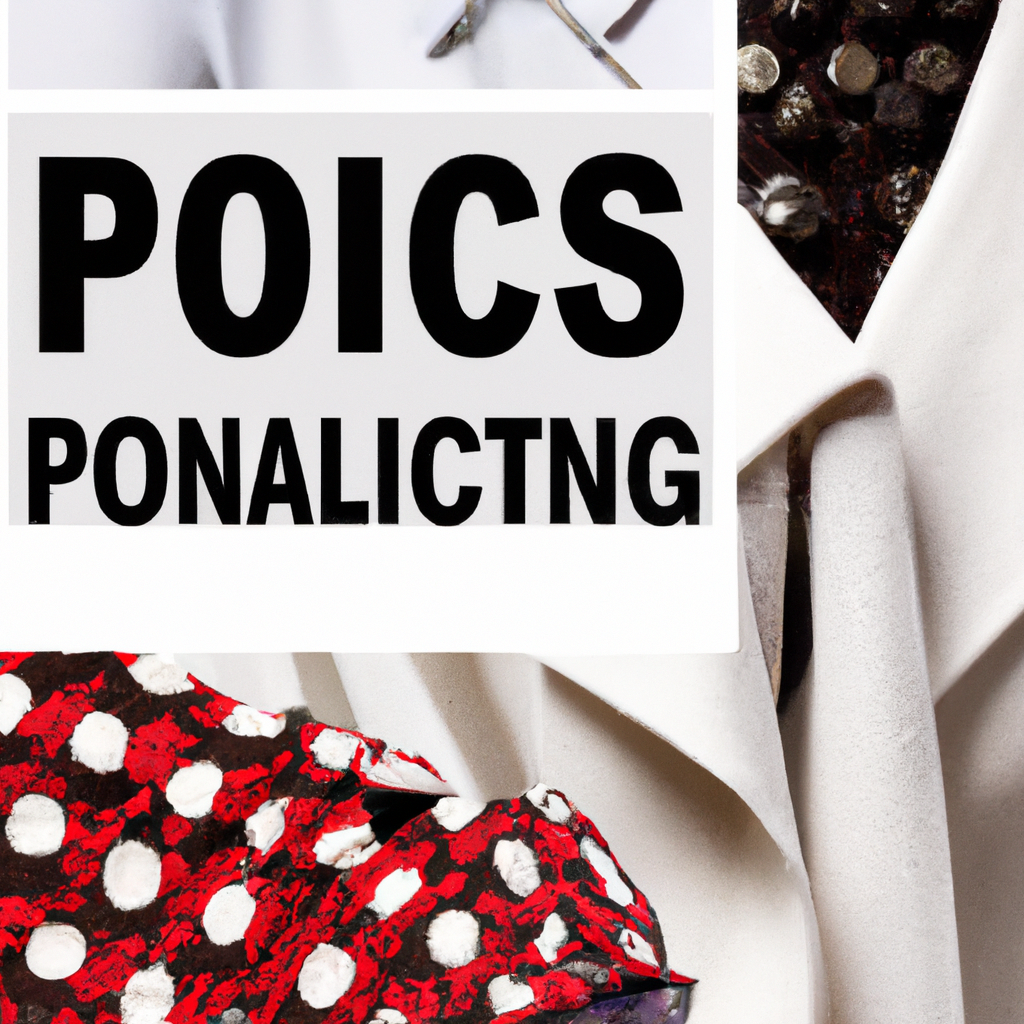From the flapper dress of the 1920s to power suits of the ’80s and street style of today, fashion has always served as an indication of shifting societal norms. As trends come and go throughout the years, there is often a parallel between worldly events and the clothing styles of the era. It is no surprise that fashion and politics have a long-standing relationship, as how we dress reflects the values and preferences of each generation. In this article, we will explore the complex and ever-changing link between fashion and politics—how style has been used to shape and reflect societal changes.
1. Introduction: Fashion and Politics
The relationship between fashion and politics has been intertwined since antiquity. It has been used to signify power for thousands of years, from Julius Caesar in ancient Rome to President Obama in the 21st century. Over time, the two have continued to evolve in step with each other, influencing each other in a variety of ways.
Fashion has a deep effect on politics, whether it be through representing status, values, or simply being a form of expression. It has an ability to unify a group of people, or show dissent with a said set of ideals. On the other hand, the developments in politics often shape and guide the current trends of fashion.
The influence of fashion is seen in headlines around the globe. Protestors igniting change in their countries proudly sport distinct clothing and convey their message with words and symbols on their clothing. The clothes they wear says a lot about their beliefs. Leaders who use fashion to define their power have a message to send and do so through the colors of their clothing, the type of hat they wear and more.
- Fashion is a powerful statement and representation of politics.
- Politics often guide current trends of fashion.
- Fashion is an effective way to convey a message.
The relationship between fashion and politics is not limited to that which is seen on television or in the newspaper. It is seen daily in our own lives and it is a tool that can be used to convey our own messages about belief or protest issues. By adopting a certain style of clothing or using certain colors, symbolism and prints, we take the message of fashion and politics to a much more personal whole.
2. Examining the Intersection of Style and Social Change
The intersection of style and social change is complex and multifaceted, and it is often necessary to examine how the two phenomena relate to each other to fully understand their impact.
- Fashion as Social Commentary
Fashion is a powerful tool of expression. As a form of creative performance, fashion has been used throughout history to make a statement on social and political issues. During times of political turmoil, movements such as punk and grunge made waves as people wore clothing that reflected their discomfort, anger, and frustration with the world at large. From the dramatic hairstyles of the Mods to the neo-hippie counterculture of the 70s, clothing has always been used as a platform for social commentary. - Style as A Social Leveler
Style can also help to level social boundaries, helping to break down rigid class distinctions. Going beyond superficial features such as price and brand, style can communicate the individual’s attitude, aspirations, and values, which can often be more important than class. By dressing in a certain way, people can come to be viewed, and view themselves, as part of a group or subculture, regardless of their material wealth or circumstances. This can lead to a greater sense of solidarity and togetherness, even amongst those who wouldn’t otherwise connect. - Clothing Accessibility and Inclusivity in Fashion
Finally, clothing and style can also be used to promote inclusivity and make fashion more accessible. By providing reasonably priced clothing that is also stylish and on-trend, companies can make fashion available to a wider range of people. This may lead to greater inclusivity and a greater sense of belonging amongst those who have traditionally felt excluded from mainstream fashion.
It is clear that style and social change are closely linked to one another, with fashion playing a powerful role in both conveying messages and promoting inclusivity. As new trends and styles emerge, we must continue to examine the intersection of the two, in order to gain a deeper understanding of their impact and significance.
3. The Cultural Significance of Fashion in Political Movements
Fashion has always been a powerful tool with which to express messages, signs, and symbols throughout the ages. It is evident in our own culture, and throughout history, that fashion has been inextricably tied to politics. Today, fashion and its associated culture has proven to be incredibly impactful in terms of sparking political movements and serving as a platform for setting agendas.
Clothing as Power
Clothing is powerful—it can be used to define gender roles, to challenge social taboos, and to bridge cultural divides. Throughout history, various revolutions, movements, and even protests are associated with certain distinct fashion norms. Think of the Black Panther uniform, the Suffragettes’ sashes, or the Clothes of the French Revolution. Wearing clothing which captures the symbolism of a political movement is an easy way to express support without saying a word.
Aesthetic as Identification
Fashion is a way of identification and of expression, and to make a statement to the world that you belong to something greater; in essence, it is an outward demonstration of internally-held political values. The aesthetics of a certain fashion movement can help to bring people together, unify cultures, and give strength to dissenters. We’ve seen this in New York’s punk scene, in San Francisco’s drag explosion, and in London’s fashion designers. All of these styles not only have cultural relevance, but they also represent a larger political message.
Fashion as Protest
- Fashion can be used as a peaceful form of protest, to spread awareness and to challenge existing social structures and power balances.
- Projects such as “Fashion Revolution” and “Vogue Not War” use the power of fashion to draw attention to global issues, to start conversations, and to draw attention to political and economic injustices.
- Fashion is also a great way to break stereotypes and to challenge gender roles—for example, men in skirts, women wearing shirts, and so on.
Fashion has always been a powerful form of expression, and it is undeniable that it can play an important role in political movements by helping to bring people together and galvanise support. It enables us to challenge status quo, to challenge taboos, and to ultimately make a statement that can have an incredibly powerful ripple effect.
4. Exploring the Influence of Politics on Global Fashion Trends
When it comes to the ever-changing fashion trends, politics often plays a role. What’s fashionable on the catwalk is often determined by a mix of bold decisions from powerful influencers, societal norms, and the desire to represent a country’s core values.
- Subverting and Redefining Expectations
Political movements – both new and old, have been known to shape fashion, from the revolutionary impact of punk fashion or the deliberate use of the hijeb to defy western expectations. Iconic looks like Pablo Picasso’s Republican Guard uniform in the 1930s or Angela Davis’s signature studded afro and beret during the civil rights and black power movement, are just some of the powerful examples of how politics and fashion can co-exist. - Amplifying Current Events
High fashion collections often present as a runway commentary on current events, amplifying a political message either directly or through abstract visuals. Gucci has become an industry leader with their ‘Gucci Equilibrium’ collections, which are used to draw attention to global environmental topics. While Louis Vuitton showcased international flags in their cruise 2019 fashion show – reaffirming each countries values and different cultures. - State of Mind to Political Statements
In more recent times, politics in fashion has become more visible. GRAID, a feminist collective in Moscow, uses fashion to create conversations around autonomy, gender rights, and diversity through collections that are shirtless to signify women’s freedom. Even celebrated designers like Hermès, Versace, and Dior have used their collections to show off their progressive stance. - Unfiltered Expression
Ultimately, fashion is an expression of how people perceive themselves, and can be a representation of a certain belief or thought. It is a reflection of our current society, and its primary purpose is to express the state of current events. Politics is one of the factors that shape fashion around the world – even if you don’t look at fashion as a ‘vehicle’ for political statements, you’ll still find them in current trends, without a doubt.
The marriage between politics and fashion will always remain, and only strengthen with age. It is both a platform for powerful statements and acts as an unspoken form of communication. It’s an ever-evolving space, and its effects on fashion trends will remain visible – no matter how much the industry changes.
Fashion is more than just what trends are in, it is an art form reflecting and commenting on social change and politics. With every change in fashion, a message is broadcast that speaks to the state of society, empowering those wearing it to make a vocal statement on the current political climate. By changing the way we dress, we become an emblem of our evolving social values, demonstrating that fashion will always be an avenue by which we can both drive and combat conversations about current political issues.

